Environmental Consciousness: To what extent are stainless steel anchor chains more environmentally friendly than galvanized anchor chains?
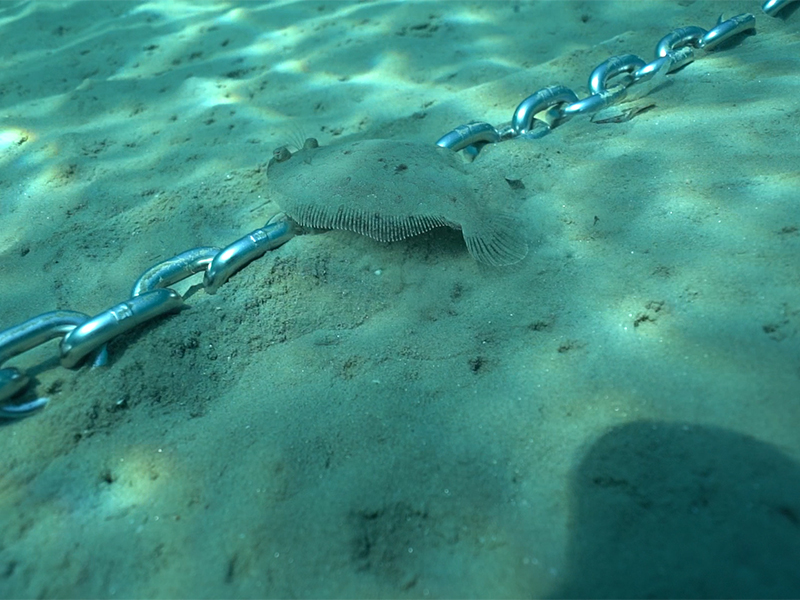
The potential hazard to maritime life, created by the use and impact of zinc, represents an essential factor that cannot be ignored any longer.
Zinc concentrations in seawater have reached an alarmingly high level, which poses a serious threat to aquatic life as zinc produces acute toxicity.
Given the fact that in the course of corrosion processes, which are prevalent in and typical for galvanized anchor chains, substantial amounts of zinc are released into seawater at times, this destructive development is even further supported.
Stainless steel anchor chains, however, actively contribute to protecting marine life by uniting the aspects of exceptional durability with the philosophy of consistent environment-friendliness and sustainability.
Material Selection: Galvanized steel chains or stainless steel chains?
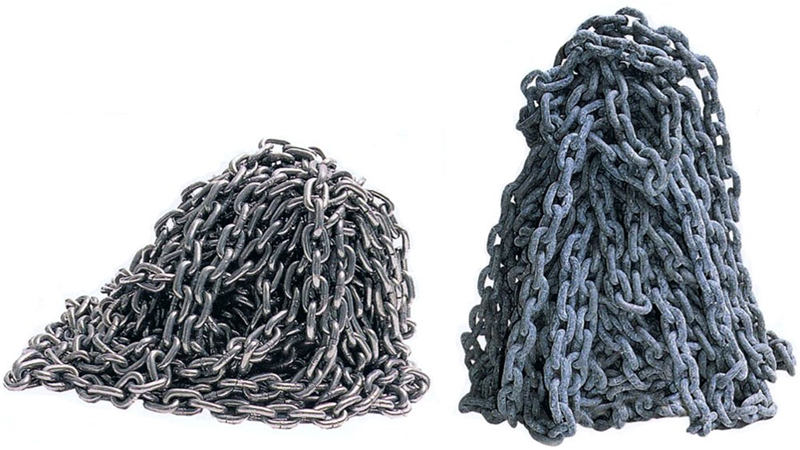
Stainless steel chains have proven to be higher quality anchor chains: not only are they superior in terms of longevity/durability, but also in terms of environmental protection and sustainability in every respect. As alloying elements, chrome, nickel, and molybdenum, among others, are used.
With elaborate surface finishes, stainless steel chains slide into anchor lockers without jamming. Galvanized chains, on the other hand, are typically much rougher, thus causing them to pile up during anchor retrieval and, in the worst case, block the winch.
Furthermore, high-quality stainless steel anchor chains hang by straight drop lines, which is achieved by precise manufacturing and, especially, by an even dimensioning of the chain links. For this purpose, almost exclusively German manufacturers calibrate their anchor chains, thus ensuring a smooth and safe run on the anchor winch.
Galvanized anchor chains may attract boaters with lower purchase prices, but they wear out significantly faster. Frequently, as a result of the abrasion of the zinc coating, the chains exhibit signs of corrosion after only one season. As corrosion progresses, the diameter of the chain links decreases, which consequently reduces the holding force of the entire anchor chain.
From an aesthetic point of view, rusty anchor chains also afford a very unappealing appearance: they cause gelcoat discoloration in the chain area, which then creates unsightly and persistent marks and stains on the hull and deck.
Interesting Facts: Which criteria should be taken into account before selecting an anchor chain?
Corrosion: Which alloy is particularly robust?
Various materials and/or their alloys are marked with different numbers, providing information on their composition/properties. 1.4401, for instance, pertains to DIN (= Deutsches Institut für Normung = German Institute for Standardization) or EN (= Europäische Norm = European Standard) – AISI 316, on the other hand, is a classification of the American Iron and Steel Institute.
An essential factor in the selection of materials is the lowest possible carbon content in the alloy. A high carbon content fosters an increased formation of chromium carbides, which in turn promote intercrystalline corrosion. Stainless steels with low carbon content, for example, can be identified by the material designations 1.4301 (AISI 304) or 1.4401 (AISI 316).
For yacht use, stainless steel anchor chains with the designation 1.4404 (AISI 316L), which has a lower carbon content than 1.4401, are recommended. In the U.S. designation AISI 316L, this is indicated by the suffix L (for "low carbon").
When sailing in warm, salty waters, anchor chains made of duplex stainless steel (1.4462 or AISI 318LN) or super duplex stainless steel (1.4507 or AISI F255) should be selected. Duplex materials are produced with an alloy that is even more robust and resistant to high temperatures and corrosion than 1.4404 or AISI 316L by comparison.
Test Procedures: What do PREN and CPT stand for?
PREN stands for "Pitting Resistance Equivalent Number", CPT is the abbreviation for "Critical Pitting Temperature". These values are measured in ASTM (American Society for Testing and Materials) test procedures and provide information about the resistance of a material in warm and salty waters.
The authoritative test method for corrosion-resistant steel is ASTM G48. As a basic principle, the higher the PREN value, the more corrosion-resistant the steel. With a PREN value of more than 35, a stainless steel is seawater-resistant.
Additionally, the CPT value (temperature measurement value for incipient pitting) has to be taken into consideration. For this purpose, the lowest temperature at which pitting occurs will be determined in accordance with ASTM G150.
Stainless Steel Anchor Chains: What are the differences between the individual grades?
If anchor chains have to meet high requirements – for example, in the yachting sector –, Ketten Wälder GmbH indicates grade 60+. Compared to anchor chains up to grade 50 (other manufacturers), grade 60+ chains offer higher tensile strength and breaking force at identical chain diameters. This allows the use of smaller chains, which again saves weight.
| Material | AISI 316L | AISI 318LN Duplex | AISI F255 Superduplex |
| Quality Grade | 6 | 6 PLUS | 7 PLUS |
| Breaking Force in kN at 8 mm Chain Thickness (Optimum Value) | 63 kN | 66 kN | 80 kN |
| PREN | 23.10 to 28.50 | 30.85 to 38.07 | 37.00 to 44.00 |
| CPT in °C | 24.0 to 27.5 °C | 27.5 to 34.5 °C | > 70.0 °C |
comparison of grade, breaking force, PREN, CPT
Stainless Steel Anchor Chains: Are there variations in the material?
As a matter of fact, the chemical compositions of the respective materials may vary. If you do not want to take any risks with this, you should make sure that the manufacturer guarantees high standards in terms of material quality. It is advisable to inquire with vendors or distributors which requirements they impose on their suppliers and to which extent they verify conformity with these. Material property testing by means of spectral analyses as well as microscopic and mechanical examinations constitute reliable quality guarantees.
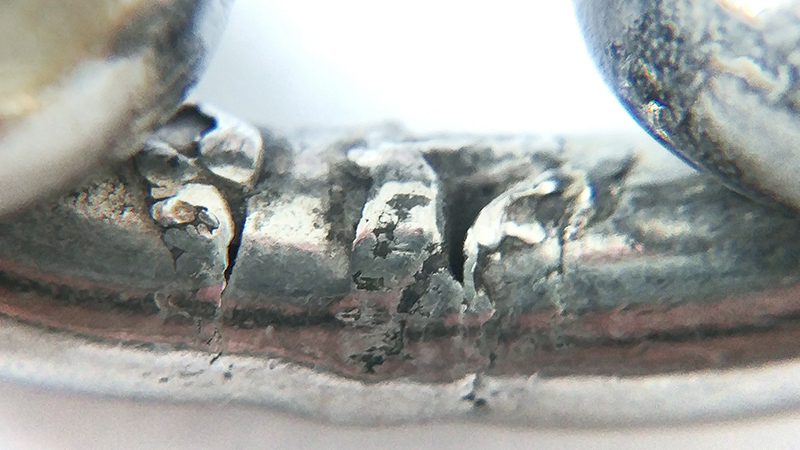
Anchor Chain Workmanship: What is the condition of the welding seams?
Stainless steel anchor chains are welded either manually or by machine. In the case of manual welding, the quality of the welding seams may vary significantly, as the risk of air inclusions, for instance, is substantially higher. Irregular, low-quality welding seams of individual chain links are also detrimental to the load-bearing capacity, and consequently to the reliability of the entire chain.
Approved mechanized welding processes, on the other hand, not only ensure a consistently uniform appearance, but also a consistently high quality of the welding seams. The DIN 766 and DIN 685 standards, which are authoritative for anchor chains, only specify two welding processes permissible for round steel chains:

- resistance (butt) welding
- flash (butt) welding
Additionally, chains have to be test-loaded (i.e. subjected to test forces) and calibrated.
In particular, low-cost mass-produced goods usually do not meet these standards. An experienced eye will easily recognize the difference between good-quality and inferior-quality welds, e.g. welding seams that are too smooth or even non-existent, without any deburring patterns.
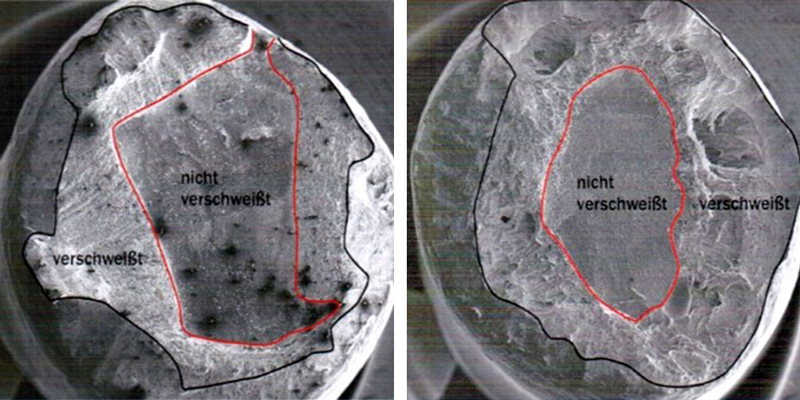
High-quality welding work is an essential and integral safety factor. When the chain is subjected to high tensile stress, the chain links will undergo deformation at first, without fracturing directly at the welding seams. Chain links welded in standard compliance typically also do not fracture at their seams – it is rather the base material that fractures in the rounding of the respective chain links. A detaching/fracturing welding seam is an obvious indication of poor workmanship.
 deformation process of the chain links at an elongation of 32% | 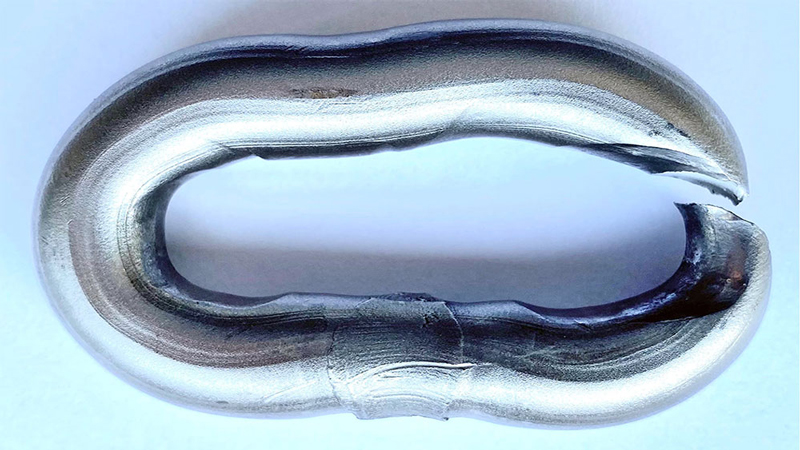 ideal damage pattern: fracture in the rounding |
Material Defects: Examples of Defective/Inferior-Quality Anchor Chains
In its 12/2008 issue, BOOTE magazine featured microscopic images taken during the testing of anchor chains (10 mm chain diameter) from various manufacturers. On display were metallurgical cuts through the welding seams of chain links.
The unambiguous test result proves that chains, butt-welded by approved machining methods, fractured significantly later and, as mentioned above, not at their welding seams, but in the rounding of the respective chain links.
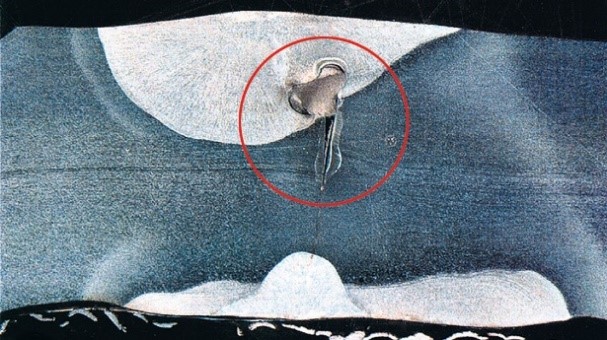 Cavity: Example 1
Cavity: Example 1
- manually welded seam with cavity (circled red)
- material: 1.4401 or AISI 316
- first deformation at a load of 43.2 kN
- fracture at 76.7 kN
© MAN Hamburg Test Laboratory
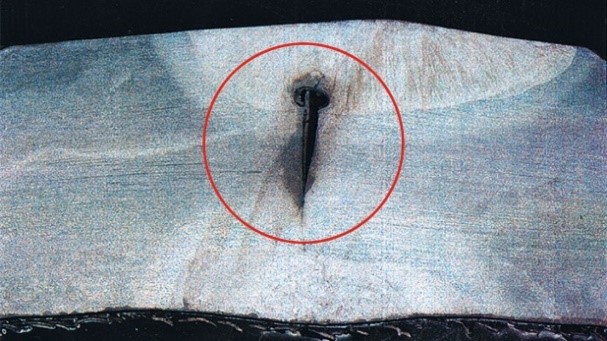 Cavity: Example 2
Cavity: Example 2
- manually welded seam with larger cavity (circled red)
- material: 1.4401 or AISI 316
- first deformation at a load of 42.0 kN
- fracture at 75.0 kN
© MAN Hamburg Test Laboratory
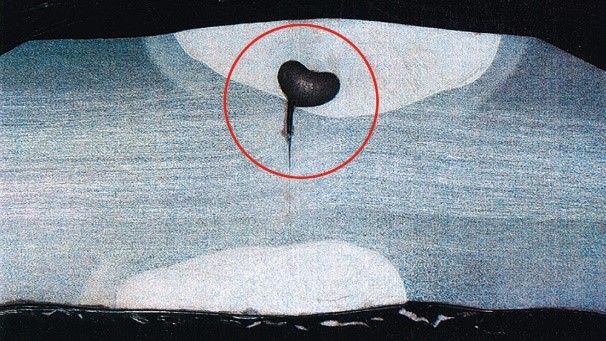 Cavity: Example 3
Cavity: Example 3
- manually welded seam with large cavity (circled red)
- material: 1.4401 or AISI 316
- first deformation at a load of 36.8 kN
- fracture at 73.4 kN
© MAN Hamburg Test Laboratory
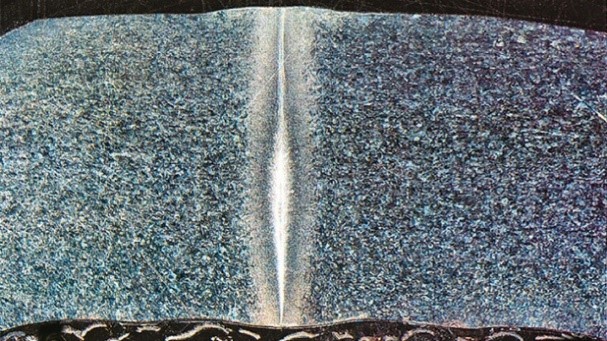 Without Defect: Example 1
Without Defect: Example 1
- butt-welded seam without defect
- material: 1.4571 or AISI 316 Ti
- first deformation at a load of 33.6 kN
- fracture at 79.2 kN (corresponding to a medium breaking load)
© MAN Hamburg Test Laboratory
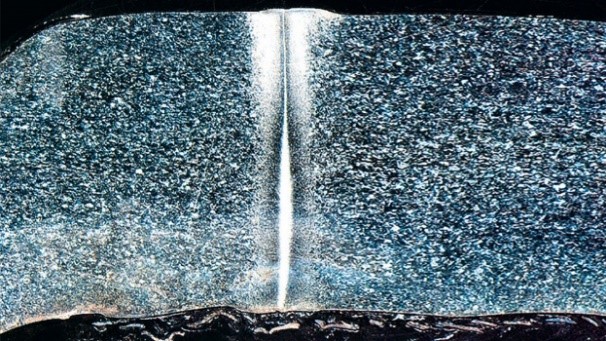 Without Defect: Example 2
Without Defect: Example 2
- butt-welded seam without defect
- material: 1.4404 or AISI 316L
- first deformation at a load of 50.0 kN
- fracture at 95.2 kN (corresponding to a very high breaking load)
© MAN Hamburg Test Laboratory
Stainless Steel Anchor Chains: Are there any discolorations?
Stainless steel anchor chains may develop blue or golden, orange to brownish and greenish discolorations through contact with organic compounds such as silt, sand, or algae. However, as soon as you anchor again in other waters, they usually recede. These discolorations neither affect the corrosion resistance nor the mechanical-technological properties of anchor chains.
Evaluation Criteria for Anchor Chain Quality: Check List
The following criteria may be used as a guideline for the selection of a high-quality stainless steel anchor chain:
- Calibration: Has the even dimensioning of the chain links been ensured by calibration?
- Surface Treatment: Is the surface of the chain smooth enough for the chain to slide smoothly into the anchor locker without piling up?
- Alloy: Does the material used comply with the required DIN or AISI standard? May duplex or even superduplex stainless steel be required?
- PREN Value: Defines the measured value for pitting/corrosion resistance – the higher the PREN value, the more corrosion-resistant the steel.
- CPT Value: Defines the measured temperature value at which pitting occurs.
- Grade: Includes data/measured values on tensile strength and breaking load – the higher the grade, the stronger the material.
- Workmanship: Have the welding seams been furnished in compliance with approved, mechanized welding processes?
Conclusion
A stainless steel anchor chain selected in accordance with the aforementioned criteria will not only correspond precisely to its intended use, but also ensure long-term reliability, safety as well as a responsible and sustainable approach to the environment.
